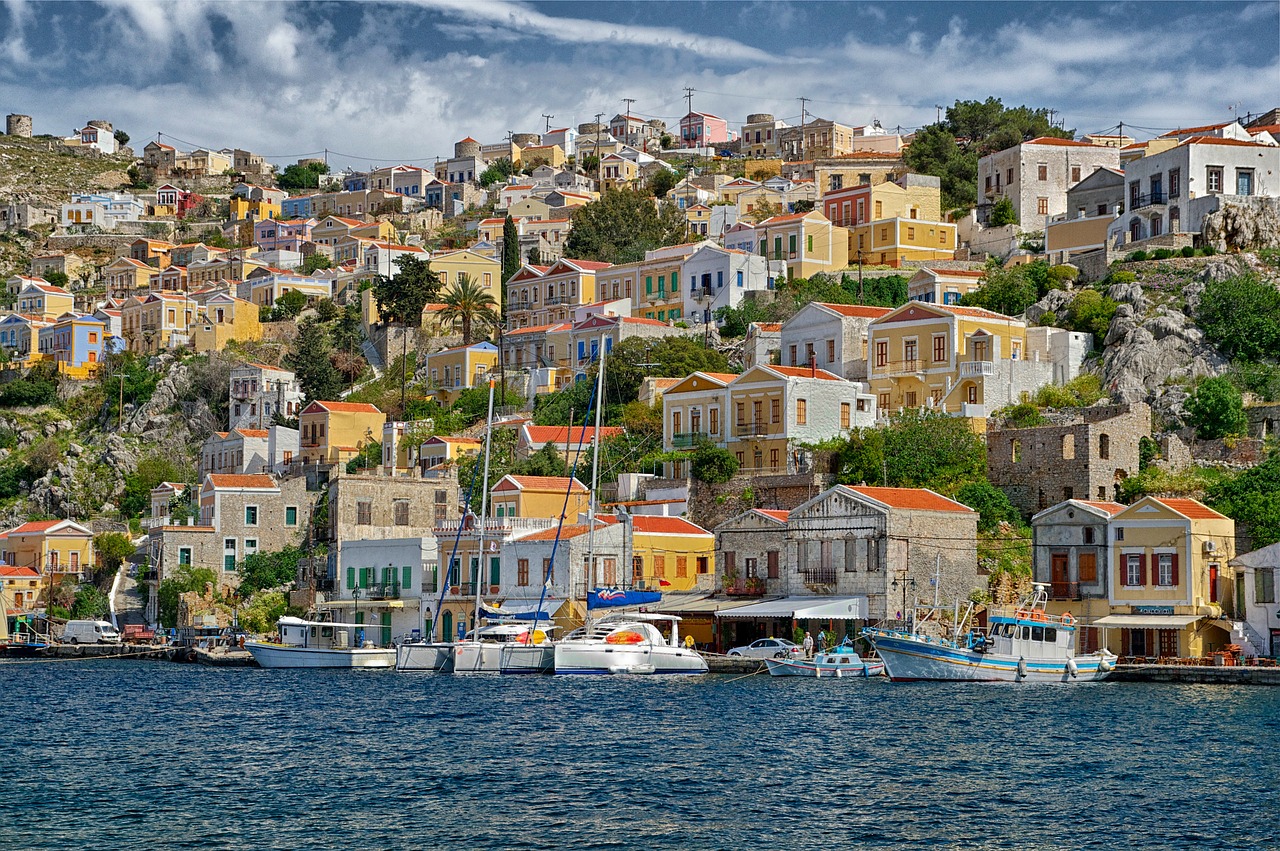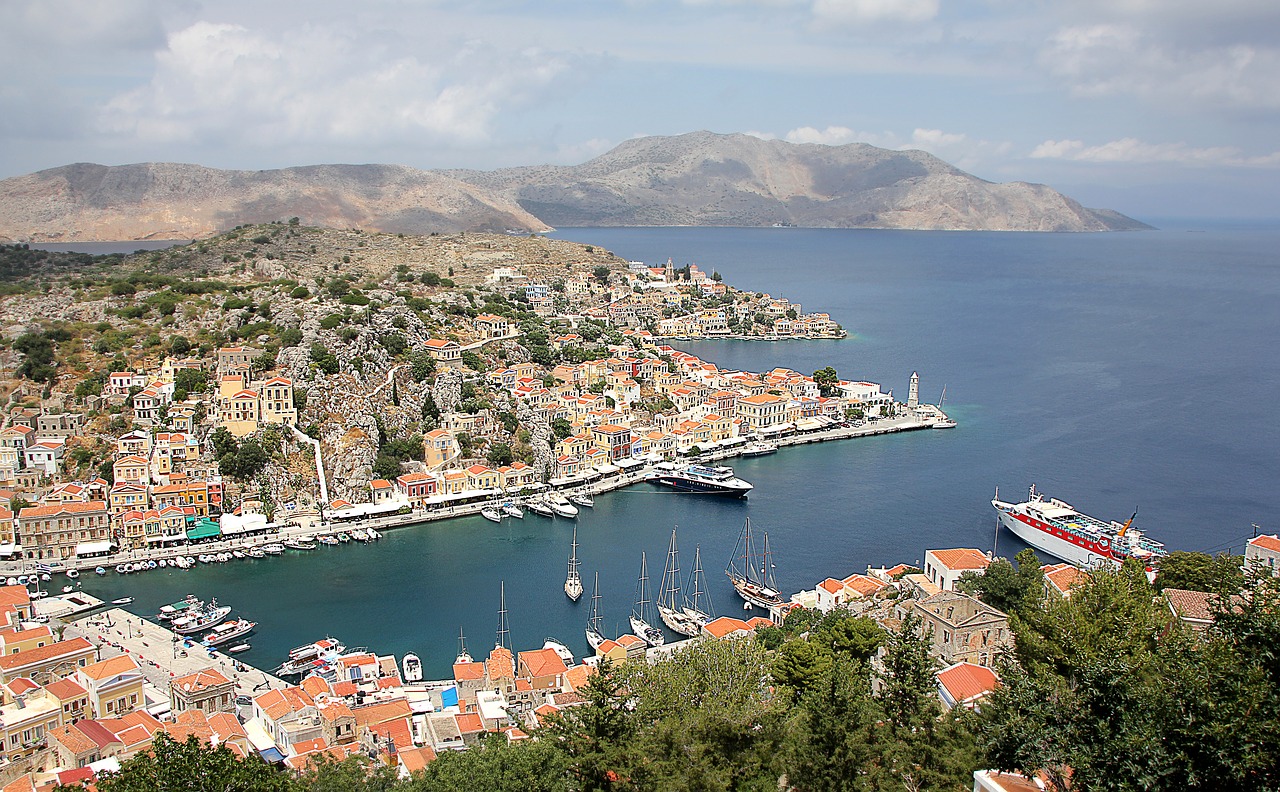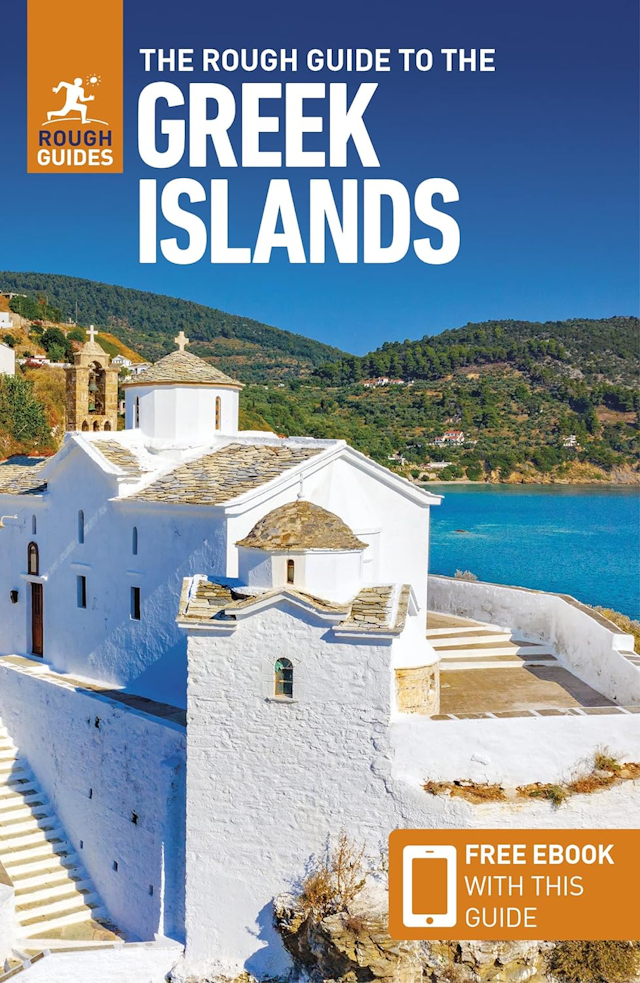- HOME
- Dodecanese
- Symi
- A Holiday on Symi
A Holiday on Symi
Mike Gerrard wasn’t sure what to expect from a holiday on Symi, in the Greek islands, but what he found was lots of local feasting, dancing, and music.
How Did Symi Get Its Name?
The Greek island of Symi gets its name from the Italian word for a monkey: scimmia. Allegedly, on this small island off Rhodes, Prometheus attempted to model a man out of clay and Zeus, worried about demarcation, promptly turned the man into a monkey.
Alternatively, Symi was the daughter of King Ialysos, abducted by the god Glaukos and brought to the island, which thereafter adopted her name. Then again, Symi was the mother of King Chthonios (try spelling that after a couple of ouzos) and he named the island in her honour.
Day Trip to Panormitis… Or Not?
No matter. Greece is the home of the dispute, and when two Greeks are talking you’ll have three different opinions. In the main town I studied the boards outside one travel agent’s office, describing various boat trips you could take. I opted to go to the monastery at Panormitis on Tuesday and went inside to book a ticket.
‘No trip to Panormitis on Tuesday. Panormitis is Thursday.’
I pointed out that it said Panormitis on Tuesday on the board outside, on the SS Triton. Within a few minutes there were four Greek men arguing in the street outside about who went where on what day. I crept away unnoticed and went round the corner to another travel agent where I booked to go to Panormitis on Tuesday on the SS Triton.
Panormitis on Symi
Panormitis is Symi’s second town, named after the island’s saint, the Archangel Michael Panormitis, who also gives his name to the monastery there which is open to visitors. That is, it is open to the quick and the dead.
The dead are already there, it’s the visitors who have to be quick. When the boat comes in, the doors of the church are opened, and ten minutes later they’re closed again as visitors are ushered into the museum.
Anyone deciding that their first need after an hour’s boat trip to get from Symi Town to Panormitis is a sit-down and a drink rather than visit the church will have to sit down and have a second drink and wait till another boat arrives and the church is opened again. You’ll still only have ten minutes, but the wait shouldn’t take long as Panormitis is a popular stop on the day-trips that come from Rhodes all day long.
Sotiros Name Day
Anyone day-tripping from Rhodes on August 6th might have wondered why the boat missed the main harbour at Symi Town and instead went steaming into the bay next door to dock briefly before doling a U-turn out again and finally docking in the main harbour, where it should have done.
The explanation is simple. August 6th is a name-day, when all the men named after St Sotiros get together and celebrate the fact that they are called Sotiros. In the morning there’s a church service in Nimborio, a tiny place just along the coast from Symi Town, so the boat needs to take all the Sotiroses from Rhodes to Nimborio, to save them walking there. Who knows, maybe the captain is called Sotiros.
After the service, a flotilla of tiny boats leaves Nimborio and then into the harbour steams the Lindos 1, a boat so big that it should no more be able to tie up in Nimborio than an elephant should be able to bathe in an eye-bath. But Greek captains know their job and tie up it does, and more Sotiroses disembark. The Lindos I hoots its respects to the church, the old lady in charge of the church bells rings back a greeting, and the ferry leaves again and takes the few hundred bemused day-trippers, who have no idea what’s going on, to their rightful destination in Symi Town.
The Feast of St Sotiros
That evening, everyone was welcome to the feast, where most heads would turn if anyone yelled ‘Sotiros!’ One small notice that I’d spotted in town invited locals and visitors alike to the feast, but only about ten of us mingled with maybe a hundred Greeks and ate and drank and listened to bouzouki music and watched the dancing.
If you’ve ever been to a Greek night and seen a man lift a table up in his mouth, and thought that this was something put on for tourists, let me assure you that this is what happens when Greeks get together for themselves. And the man twirled the table around and didn’t spill a drop from the several glasses and bottled that were on there.
It says little for the foreign visitors that in the week when the young people of Symi got together and organised several nights of entertainment in the basketball ground, with music and dancing and a cookery contest, that few non-Greeks bothered to join the hundreds of locals to have a really good time.
If you want to have a good look at what Symi is like, check out our YouTube video that combines still photos and video clips of this lovely little island.

Perhaps the posters, which were only in Greek, were organised by the tourist office which was housed in the base of the clock tower. The padlock over the door doesn’t quite have rust on it yet, but it shows precious few signs of ever being used. Beyond the tower are the town’s main A-grade hotels, like the Dorian and the Aliki.
Beyond them the boatyards hint at the island’s earlier industry, and further on is the 40-minute dirt rack to Nimborio, pitted with holes and rocks and proudly described on the local map that I bought as being a ‘road of motorway standard’.
Those with the agility of a goat can climb down to hidden coves and strip off in seclusion, or alternatively hire a boat across to the island of Nimos.
Symi’s Beaches
Symi is not really an island for sunbathers, though. Its beaches are mainly stony and mostly inaccessible. It is an island for those who like their Greeks to be Greek, with a dash of daftness. The island that only has about four roads also boasts a bus service. In the wonderful book Bus Stop Symi (if you can find a copy these days: I'm not parting with mine), William Travis described how the bus stops on Symi were put up. Just the stops, as there was no bus at the time.
Now that there is a bus, it naturally ignores the stops and pulls up elsewhere, to the confusion of tourists waiting at the bus stops. For a few cents, the bus takes you from the harbour area, Yialos, up through the narrow streets of the old town of Chorio, and down the road to the next bay along, Pedi, where the Pedi Beach Hotel dominates the little beach.
The bus, a blue transit van with ‘The Symi Bus’ painted in white on the sides, goes every 30 minutes and is governed by the laws of bus-boarding that prevail everywhere in Greece. One visitor complained that although he was at the front of the queue when the bus arrived, there were three locals on board before he’d even moved.
Don't miss reading about the time we spent Easter on Symi!
The Food of the Gods
Eating is good on Symi, as the island is rich in herbs, and the Symiotes use them generously. At Giorgio’s Taverna, up in the old town and packed by 8.30 every night, the chef does a lamb special where a good cut of meat is placed on a slice of potato, swamped with garlic, oregano, cumin and other herbs and spices, topped with tomatoes and a slice of feta, foil-wrapped and cooked for five hours. Those who climb the 500 steps from Yialos to Chorio find it tastes like the food of the gods.
Heaven on Earth
This story also appears in Heaven on Earth, a collection of travel writing about Greece by Mike Gerrard, co-publisher of Greece Travel Secrets. The book includes accounts published in newspapers and magazines of some of Mike's most memorable experiences of travelling in Greece. Click here or on the cover image to take a look.
Latest Posts
-
The Lesser-Known Traditions of Greek Easter
Step off the beaten path this spring and discover the enchanting — and often surprising — Easter traditions found across Greece. -
Easter in the Mystical Castle of Monemvasia
In the castle town of Monemvasia, with its dramatic medieval backdrop and sea views, Easter is a deeply spiritual and atmospheric experience. -
Sifnos: Greece’s Hidden Culinary Star on the Rise
Sifnos, a Cycladic island, is gaining fame for its rich culinary heritage, especially the beloved melopita honey-cheese tart. -
Easter in Leonidio: A Tapestry of Light, Culture and Cliffs
In Leonidio, Easter comes alive with handmade hot air balloons in the sky and lanterns made from bitter oranges in the streets. -
April 9 Strike in Greece to Impact Public Transport, Ferries and Air Travel
Transportation and travel across Greece will face disruptions on Wednesday, April 9, as public transport, ferry and aviation workers join a nationwide strike called by Greek labor unions. -
Ancient Theater of Lefkada Brought Fully to Light Following Systematic Excavation
The Greek Culture Ministry has announced that the first ancient theater ever identified in the Ionian Islands has recently been brought fully to light on Lefkada, revealing an impressive monument that… -
Seven Greek Traditions Recognized as Intangible Cultural Heritage
From traditional barrel-making to age-old folk dances, seven new entries on Greece’s National Inventory preserve the country’s living heritage for future generations. -
Greek Air Traffic Controllers to Hold 24-hour Strike, Disrupting Flights on April 9
The Hellenic Air Traffic Controllers Union have announced a 24-hour strike for Wednesday, April 9, in response to the protest called by the Civil Servants’ Confederation (ADEDY). The strike is being h… -
Ten Best Budget Hotels on Santorini
Greece Travel Secrets picks the ten best budget hotels on Santorini, some with caldera views, some near beaches and some close to the heart of Fira. -
No Ferries in Greece on April 9 as Seamen Join Nationwide Strike
The Pan-Hellenic Seamen’s Federation (PNO) has announced its participation in the 24-hour strike called by the General Confederation of Greek Labor (GSEE) on Wednesday, April 9. The strike, which will…














